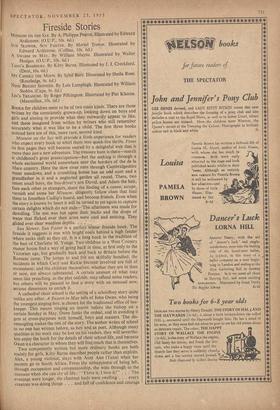Fireside Stories
MINNOW ofi THE SAY. By A. Philippa Pearce. Illustrated by Edward Ardizzone. (O.U.P., 10s. 6d.)
SUN SLOWER, SUN FASTER. By Meriol Trevor. Illustrated by Edward Ardizzone. (Collins, 10s. 6d.) A SWARM IN MAY. By William Mayne. Illustrated by, Walter Hodges. (O.U.P., 10s. 6d.) MY CANDLE THE MOON. By Sybil Burr. Illustrated by Sheila Rose. (Routledge, 9s. 6d.) NINE BRIGHT SHINERS. By Lois Lamplugh. Illustrated by William Stobbs. (Cape, 9s. 6d.) JAN'S TREASURE. By Roger Pilkington. Illustrated by Piet Klaasse. (Macmillan, 10s. 6d.) BOOKS for children seem to be of two main kinds. There arc those written by the consciously grown-up. looking down on boys and girls and aiming to provide what they outwardly appear to like, and those imagined from within by writers wlio still remember accurately what it was like to be a child. The first three books noticed here are of this, more rare, second kind.
Minnow on the Say will provide a fresh experience for readers who expect every book to whirl them into quick-fire thrills. From its first pages they will become snared by a delightful web that is more than just a new adventure. The treasure hunt is there—search is childhood's great preoccupation—but the seeking is through a whole enchanted world somewhere near the borders of tho de la Mare country. Here the slow river runs through Cambridgeshire water meadows, and a crumbling house has an odd aunt and a grandfather in it and a neglected garden all round. There, two intent small boys, the bus-driver's son David, and Adam the heir, face each other as strangers, share the finding of a canoe, scrape, varnish and name her Minnow, diligently follow clues that lead them to Jonathan Cudlip's hoard, and become friends. Even when the story is known by heart it will be turned to yet again to capture certain delights which do not stale—The afternoon was made for dawdling. The sun was hot upon their backs and the drops of water that flicked over their arms were ctol and enticing. They glided over clear weedless depths. . .
Sun Slower, Sun Faster is a perfect Winter fireside book. The fireside it suggests is one with bright coals behind a high fender where socks shift as they air. It is a long book in the tradition of the best of Charlotte M. Yonge. Two children in a West Country manor house find a way of going back in time, at first only to the Victorian age, but gradually back and back to Britain before the Romans came. The jumps to and frb are skilfully handled; the incidents in which Cecil and Rickie become involved are full of excitement; and the children themselves, whether they.are in then or now, are always substantial. A certain amount of what may seem like preaching, as the plot unfolds, may offend some readers, but others will be pleased to find a story with an unusual new, serious dimension to enrich it.
A cathedral choir school is the setting of a schoolboy story quite unlike any other. A Swarm in May tells of John Owen, who being the youngest singing boy, is chosen for the traditional office of bee- keeper. This means singing an introit before the bishop on a certain Sunday in May. Owen funks the ordeal, and in avoiding it gets at cross-purposes with himself, boys and masters. The dis- entangling makes the rest of the story. The author writes of school as no one has written before, as boy and as poet. Although many qualities in his work may be lost on his readers, they will neverthe- less enjoy the book for the details of choir school life, and because Owen is a character in whom they will find,much that is themselves.
Two competently written but more ordinary books are both mainly for girls. Kitty Barne describes people rather than exploits. Alex, a young violinist, stays with Aunt Ann (Tann) when her parents go to South Africa. From the unhappiness of being left, through occupation and companionship, she wins through to the moment when she can cry of life : ' "I love it, I love it !" . . . The evenings were longer, the chestnut buds were swelling • . every creature was doing things . . . and full of confidence and courage and music, she was doing them too.' My Candle the Moon is a pleasant, romantic tale of fat, freckled Pauline being bowled over by a half Red Indian, back-to-nature young man who comes from Canada with the seed of a rare orchid which he has to deliver to a forgotten address.
Nine Bright Shiners (there is only the thinnest excuse for the splendid title) is a second instalment telling more of the doings of a group of children who live by the sea. They build and race a sand-yacht, and unbury an old chapel in the sand-dunes. Readers may share a busy, breezy holiday with the satisfaction of a modest treasure trove in the end. Jan's Treasure is far from modest—'He was buried up to the knees in diamonds, rubies, pearls and jewels of every description, a gorgeous glittering heap. . . .' The hunt in this book has a practical, small-boat-handling background. Four children take an ex-naval harbour launch across the Channel to Holland, in search of some jewels cached during the German occu- pation. The fact that another gang is also on the trail gives a chance for a fine sea battle at the last moment.
PAMELA WHITLOCK



























































 Previous page
Previous page